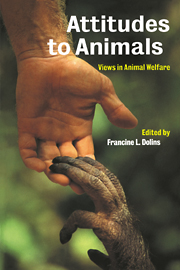Book contents
- Frontmatter
- Contents
- List of contributors
- Acknowledgements
- Part I Attitudes to animals
- Part II Animal awareness
- Part III Animal welfare
- 9 Animal welfare: the concept of the issues
- 10 New perspectives on the design and management of captive animal environments
- 11 Should we let them go?
- Part IV Research and education
- Part V Epilogue: the future of wild animals
- Index
10 - New perspectives on the design and management of captive animal environments
Published online by Cambridge University Press: 16 November 2009
- Frontmatter
- Contents
- List of contributors
- Acknowledgements
- Part I Attitudes to animals
- Part II Animal awareness
- Part III Animal welfare
- 9 Animal welfare: the concept of the issues
- 10 New perspectives on the design and management of captive animal environments
- 11 Should we let them go?
- Part IV Research and education
- Part V Epilogue: the future of wild animals
- Index
Summary
The past decade or two has seen a revolution in the way in which we perceive the needs of animals in captivity. Nowhere are these changes seen more clearly than in the husbandry and design of enclosures for zoo animals. Exhibits in the past were seen merely as showcases for the exhibition of animal collections. Currently, they are increasingly envisaged as miniature habitats resembling the wild habitat of their occupants in which animals are encouraged to exhibit natural behaviours. The husbandry and design techniques used to achieve this are often referred to as environmental enrichment.
Although the primary motivation for environmental enrichment has stemmed from a desire to improve the welfare of zoo animals, there are many other benefits to be had. Many studies have shown that active animals performing natural behaviours within naturalistic settings are more attractive to the public and are perceived more favourably by zoo visitors (Sommer, 1972; Rhoads & Goldsworthy, 1979; Tripp, 1985; Shettel-Neuber, 1988), thus increasing the impact of conservation education. Increased reproductive success of endangered species has also been attributed to environmental enrichment (Dahl, 1982; Frisch, 1987) and it is likely that reintroduced animals emanating from more enriched captive environments will have higher rates of survival in the wild (Beck et al., 1986; Dietz et al., 1987; Shepherdson, 1994).
Life in the wild is full of hard choices. Feeding, grooming and travelling between resources such as nesting sites, food and mates are just a few of the wide range of behaviours that wild animals must employ each day of their lives in order to survive and reproduce.
- Type
- Chapter
- Information
- Attitudes to AnimalsViews in Animal Welfare, pp. 143 - 151Publisher: Cambridge University PressPrint publication year: 1999
- 3
- Cited by



